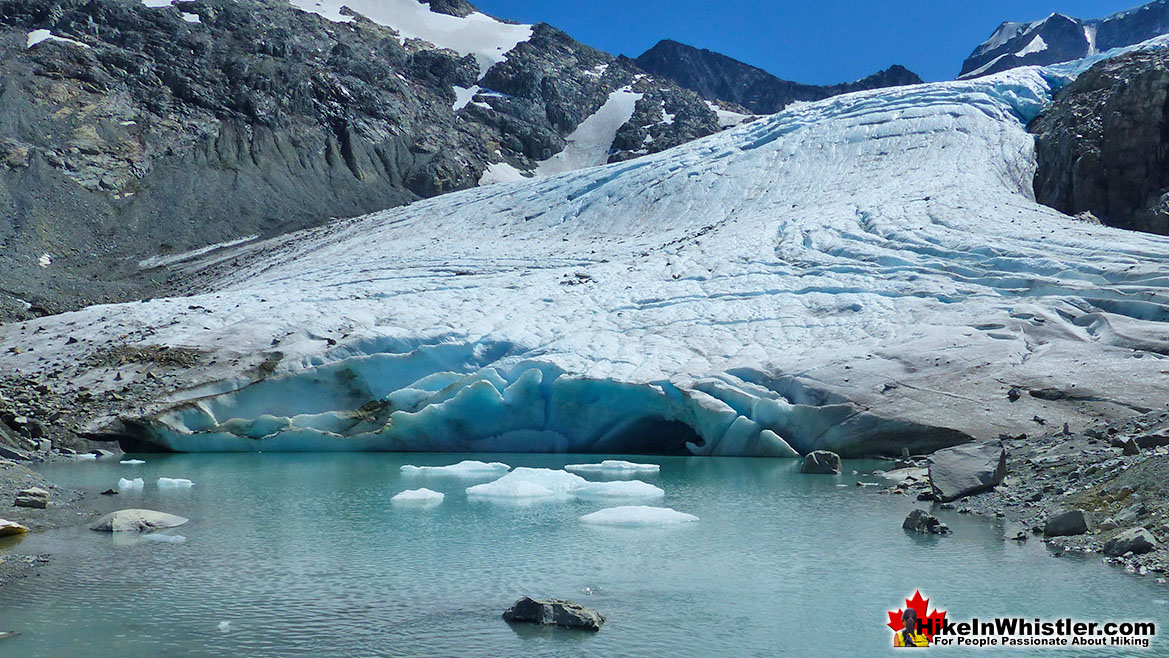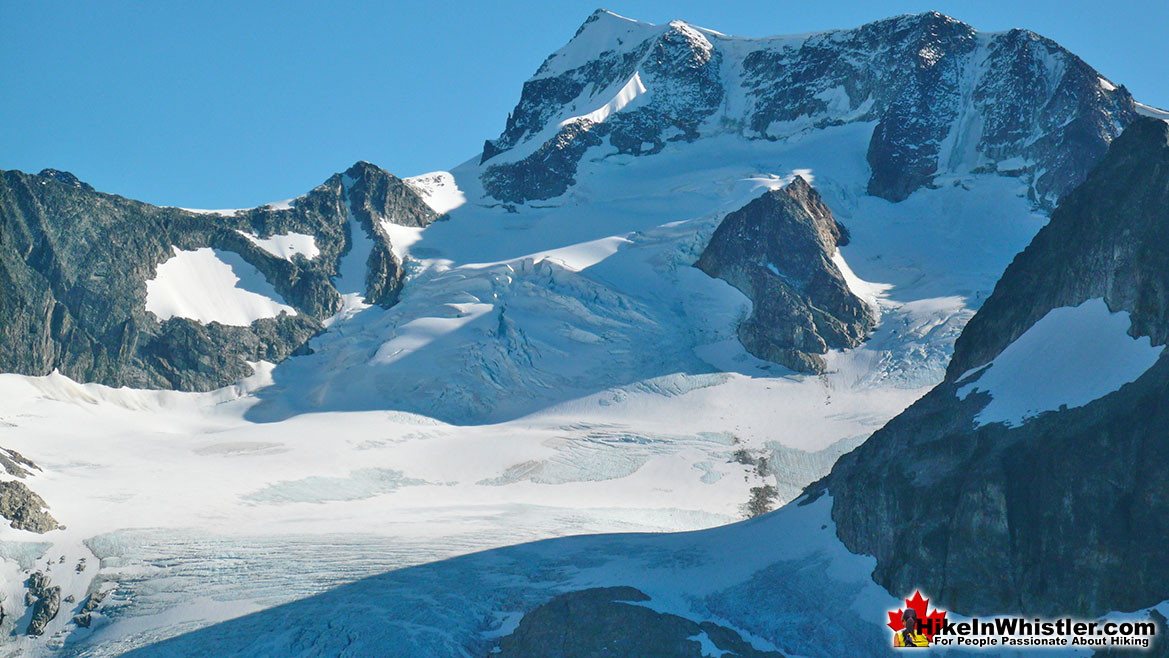Ablation Zones in Garibaldi Park, Whistler
 Ablation Zone: the lower altitude region of a glacier where there is a net loss of ice mass due to melting, sublimation, evaporation, ice calving or avalanche. The ablation zone of a glacier such as the Wedgemount Glacier has meltwater features such as englacial streams and a glacier window. An englacial stream refers to meltwater flowing inside a glacier. A glacier window is a cave-like opening at the mouth of a glacier where meltwater runs out. The ablation zone is located below the firn line. Firn originated from Swiss German and means "last year's snow". It has been compacted and recrystallized making it harder and more compact than snow, though less compact than glacial ice. A glacier such as the Wedgemount Glacier which stretches from Wedge Mountain down toward Wedgemount Lake, the ablation zone is very beautiful. A big pool of meltwater spills down the rock face and into turquoise coloured Wedgemount Lake. The pool of water is at the toe of Wedgemount Glacier and the large glacier window appears like a huge, gaping mouth. Big chunks of ice float in the pool and chunks of glacier split off into the water. Whistler and Garibaldi Park Geology: Ablation Zone continued...
Ablation Zone: the lower altitude region of a glacier where there is a net loss of ice mass due to melting, sublimation, evaporation, ice calving or avalanche. The ablation zone of a glacier such as the Wedgemount Glacier has meltwater features such as englacial streams and a glacier window. An englacial stream refers to meltwater flowing inside a glacier. A glacier window is a cave-like opening at the mouth of a glacier where meltwater runs out. The ablation zone is located below the firn line. Firn originated from Swiss German and means "last year's snow". It has been compacted and recrystallized making it harder and more compact than snow, though less compact than glacial ice. A glacier such as the Wedgemount Glacier which stretches from Wedge Mountain down toward Wedgemount Lake, the ablation zone is very beautiful. A big pool of meltwater spills down the rock face and into turquoise coloured Wedgemount Lake. The pool of water is at the toe of Wedgemount Glacier and the large glacier window appears like a huge, gaping mouth. Big chunks of ice float in the pool and chunks of glacier split off into the water. Whistler and Garibaldi Park Geology: Ablation Zone continued...

Accumulation Zones in Garibaldi Park, Whistler
 Accumulation Zone: the area where snow accumulations exceeds melt, located above the firn line. Snowfall accumulates faster than melting, evaporation and sublimation removes it. Glaciers can be shown simply as having two zones, the accumulation zone and the ablation zone. Separated by the glacier equilibrium line, these two zones comprise the areas of net annual gain and net annual loss of snow/ice on a glacier. The accumulation zone stretches from the higher elevations and pushes down, eventually reaching the ablation zone near the terminus of the glacier where the net loss of snow/ice exceeds the gain. The Wedgemount Glacier in Garibaldi Provincial Park in Whistler is an ideal place to see an accumulation zone up close. From across Wedgemount Lake you can see the overall picture of both the accumulation zone and ablation zone of a glacier. The Wedgemount Glacier is also relatively easy and safe to examine closely and hike onto. The left side of the glacier is frequented in the summer and fall months by experienced hikers on their way to Wedge Mountain and Mount Weart. Extreme caution is always needed and if you don't know how to remain safe while travelling on a glacier, you should avoid doing so. Whistler and Garibaldi Park Geology: Accumulation Zone continued...
Accumulation Zone: the area where snow accumulations exceeds melt, located above the firn line. Snowfall accumulates faster than melting, evaporation and sublimation removes it. Glaciers can be shown simply as having two zones, the accumulation zone and the ablation zone. Separated by the glacier equilibrium line, these two zones comprise the areas of net annual gain and net annual loss of snow/ice on a glacier. The accumulation zone stretches from the higher elevations and pushes down, eventually reaching the ablation zone near the terminus of the glacier where the net loss of snow/ice exceeds the gain. The Wedgemount Glacier in Garibaldi Provincial Park in Whistler is an ideal place to see an accumulation zone up close. From across Wedgemount Lake you can see the overall picture of both the accumulation zone and ablation zone of a glacier. The Wedgemount Glacier is also relatively easy and safe to examine closely and hike onto. The left side of the glacier is frequented in the summer and fall months by experienced hikers on their way to Wedge Mountain and Mount Weart. Extreme caution is always needed and if you don't know how to remain safe while travelling on a glacier, you should avoid doing so. Whistler and Garibaldi Park Geology: Accumulation Zone continued...

Adit Lakes in Garibaldi Park, Whistler
 Russet Lake sits in a wide, glacier carved valley at the base of The Fissile. In the direction opposite The Fissile, up on a plateau less than a kilometre away are two small tarns called Adit Lakes. Adit Lakes sit in a broad, boulder strewn alpine zone with an incredible view of Spearhead Range. Just a few metres from Adit Lakes the plateau drops off quickly into the huge valley that separates the Spearhead Range and Fitzsimmons Range. The Spearhead Range is named for its jagged array of spearhead shaped peaks that extend to include Blackcomb Mountain. Adit Lakes sit on a plateau in Fitzsimmons Range. From Adit Lakes you can look across the Musical Bumps all the way to the summit of Whistler Mountain. Musical Bumps is the collective name for the series of broad mountain peaks that have musical names. Viewed from Adit Lakes are Oboe Summit, Flute Summit and Piccolo Summit. The Singing Pass trail connects from the Musical Bumps trail and takes you down the valley between Whistler Mountain and
Read more
Russet Lake sits in a wide, glacier carved valley at the base of The Fissile. In the direction opposite The Fissile, up on a plateau less than a kilometre away are two small tarns called Adit Lakes. Adit Lakes sit in a broad, boulder strewn alpine zone with an incredible view of Spearhead Range. Just a few metres from Adit Lakes the plateau drops off quickly into the huge valley that separates the Spearhead Range and Fitzsimmons Range. The Spearhead Range is named for its jagged array of spearhead shaped peaks that extend to include Blackcomb Mountain. Adit Lakes sit on a plateau in Fitzsimmons Range. From Adit Lakes you can look across the Musical Bumps all the way to the summit of Whistler Mountain. Musical Bumps is the collective name for the series of broad mountain peaks that have musical names. Viewed from Adit Lakes are Oboe Summit, Flute Summit and Piccolo Summit. The Singing Pass trail connects from the Musical Bumps trail and takes you down the valley between Whistler Mountain and
Read more